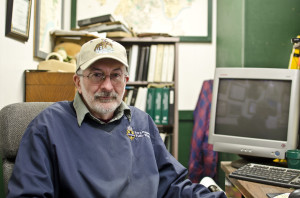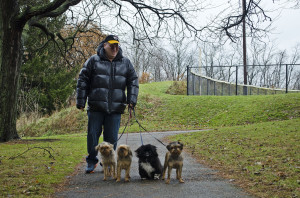Frick Park’s groundskeeper keeps community green
by Jesse DiRenzo
Frick Park is not just a plot of well-manicured earth. It is a key component of Squirrel Hill’s quest to form a lifelong bond with nature. The park is a 644-acre ode to naturalism with ridges, ravines and creeks that serves as a home to native plant and animal species.
Its story begins almost a century ago, with a quarrel between father and daughter.
Henry Clay Frick was a man of significant status in the early 20th century, and he wished his daughter the same life. He was determined to have his daughter, Helen, become a member of New York high society. Helen, however, wanted to return to the family residence, Clayton, in Point Breeze, and had no desire to become a debutante fated to marry early by contract. In defiance of her father, Helen’s debutante ball was held in Pittsburgh. Distraught over her father’s displeasure, she reached out to him.
“Father, mine, won’t you come to my party?” she pleaded. Like any man who loves his daughter, he caved at her insistence.

Dick Wilford, the longtime foreman of Frick Park, cares deeply about the community.
Photo by Alyssa Kramer
At the party, Helen asked her father if he would honor a promise he made to her as a young girl – to create a park for the children of Pittsburgh. She wanted a place where kids could be safe from playing in the street; a place where nature would provide education and entertainment.
Her father would keep his promise. Upon his death in 1919, Frick bequeathed 151 acres of land south of his Clayton estate to the city of Pittsburgh, as well as an additional $2 million trust fund to aid in its creation and long term maintenance. In 1927, Frick Park opened to the general public, and almost 90 years later, his promise to his daughter remains intact.
The park’s ideals still ring true, due in part to the people who have made it their mission to protect it, including Dick Wilford, who has served as the foreman of Frick Park for 20 years. Upon walking into Dick’s office, one is greeted almost immediately with a sign reading, “Attention! This is the office of a dedicated hunter. Expect day-dreaming, tall tales and sporadic attendance.”
Knowledgeable, unassuming and charismatic, Dick fosters an abiding love of nature and a background in horticulture. Though he works mainly in Frick Park, his responsibilities also include the maintenance of 27 other parks, 15 playgrounds, 11 ball-fields and about 8-9 miles of trail located in the East End area of Pittsburgh.
“It’s hard to work with nature.” Dick says. “Nature wants to do what she wants to do. There is never a dull moment.”
As foreman, Dick oversees the well-being of the park from all sides of the spectrum. Whether it’s helping the Parks Conservancy with their programs dedicated to helping children bond with nature, the rebuilding of the environmental center, dealing with the citizens of Squirrel Hill or maintenance throughout the park.
“This is the only job where you can work in the woods, and need a degree in psychology,” he jokes.
Despite everything he has seen in his time as park foreman, nothing surprises Dick more than the park’s metamorphosis: the shift “back toward nature” that residents have taken over the last two decades. Dick has seen firsthand that people are beginning to reach out to reconnect with the great outdoors.
“Twenty years ago,” Dick says, “there was hardly anybody using the park. Now it is so crowded that we have a hard time doing maintenance.”
He attributes this to a change in the social landscape, where the environment is at the forefront of importance and diversity is rampant. On any day, one can walk into the park and hear a variety of different languages being spoken.
The joy that Dick gains from the park is immeasurable, and what makes it special is that it’s rooted in altruism. All he wants is for people to enjoy the park as much as he does.
“It’s kind of funny now.” Dick says, a wide smile painted across his face.“I see trees that I’ve planted 12-15 years ago that are maturing now, and I’m like, wait a minute, I planted that tree.” “Sometimes, you can go out to the top of the hill, look over the whole park, and just see people doing different things. It’s amazing.”
This was the dream of Helen Clay Frick: for children to connect with nature and to form a lifelong bond with it. And thanks to people like Dick Wilford, that dream has become a reality.

 Previous Post
Previous Post Next Post
Next Post